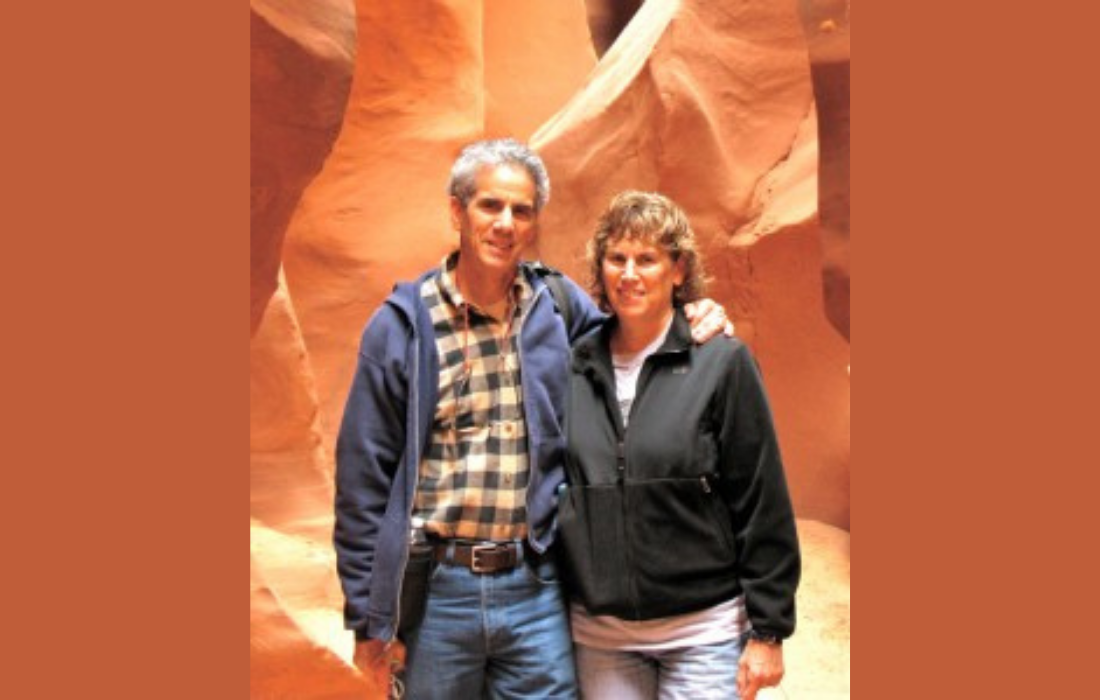Couple Undergoes Joint Replacement Surgery

The Gordons Put Their Lives Back in Motion
Husband and wife, Gil and Ellen Gordon, love their active life. Gil enjoys hiking and biking the trails around Monmouth Junction, New Jersey, where the couple lives. Ellen gets her exercise swimming and walking on her treadmill. When Gil and Ellen each began to experience progressive joint pain, the couple came to University Orthopaedic Associates. Both Gil and Ellen turned to Dr. David Harwood, Joint Specialist, for an evaluation, and both opted for joint replacement surgery.
Gil and Ellen were no strangers to orthopaedic surgery. Back in 2000, Dr. Harwood operated on and replaced Gil’s right hip. “With my right hip, it got to the point where it was interfering with things that I wanted to do, and it became a preoccupation for me. It made me worry how far I’d have to walk,” remembers Gil. At that time, Gil traveled frequently as a consultant, and his hip pain started to limit both his life and his work. “My left side, however, always appeared arthritic on x-ray, but I had no symptoms until earlier this year,” he says. “In July it looked markedly worse. This, along with discomfort, motivated me to seek treatment.” Gil’s right hip replacement was doing its job. Now it was time to deal with the left side.
Ellen had undergone a repair of a torn meniscus in her right knee twenty years before. Now this same knee was causing distress. “I was a teacher, so I was sitting and getting up and down a lot. Soon, my hips, knees and feet started to hurt, and my whole alignment was affected,” says Ellen. “I saw Dr. Harwood five years ago and he told me then that I was ready, but I couldn’t take the time off from school.”
Six months after retiring in June 2009, Ellen had a total knee replacement using Smith & Nephew’s LEGION Total Knee System with VERILAST technology, the only knee system with a 30-year wear performance claim. Gil followed, exactly ten years to the day of his right hip replacement, with a left total hip replacement using the standard Smith & Nephew hip device. This device contains a ceramic-like ball that is scratch resistant, and a joint liner made of a special plastic that inhibits wear.
Both patients chose Robert Wood Johnson University Medical Center for their surgery. The Gordons note that the staff was wonderful and offered kind, reassuring words about Dr. Harwood. “They told us we picked the right surgeon,” Gil says. “He’s a great blend of someone who is highly competent and stays on top of his game. Talking to him is like talking to a friend.” Ellen adds, “The nurses spoke about the implants and techniques he was using and how cutting edge he is.”
Dr. Harwood has two decades of experience in hip and knee replacement, now performing upward of 400 such procedures annually. He has received special training in the Birmingham Hip Resurfacing technique, a surgery designed to treat young, athletic individuals. In addition, Dr. Harwood uses his skills and talents to instruct other orthopaedic surgeons in new techniques. He also has developed a pain management and blood loss prevention protocol that has proven very successful in the post-operative recovery of his total knee replacement patients.
After surgery, the patient’s work continues in physical therapy. Gil underwent a specific post-surgical course for hip replacement. “The physical therapy following hip replacement teaches the patient to have restricted movement for about six weeks to allow the hip to heal properly,” says Dr. Harwood.
Ellen also had a prescribed physical therapy regimen, but it was very different. Dr. Harwood continues, “Knee physical therapy is more active and involves increasing knee movement, range of motion and strength for up to three months after surgery.”
Today, the Gordons have returned to their active lifestyle with a newfound wisdom and appreciation for their personal body mechanics. “You tend to be more careful, because you don’t want to go backwards, so we’re just being smart about what we choose to do,” remarks Ellen. “But my body finally feels the way it’s supposed to. The change from last year to now is amazing.”
“These types of ailments used to mean a lifetime of disability,” says Gil. “It’s a blessing that there’s nothing I really want to do that I can’t.”

